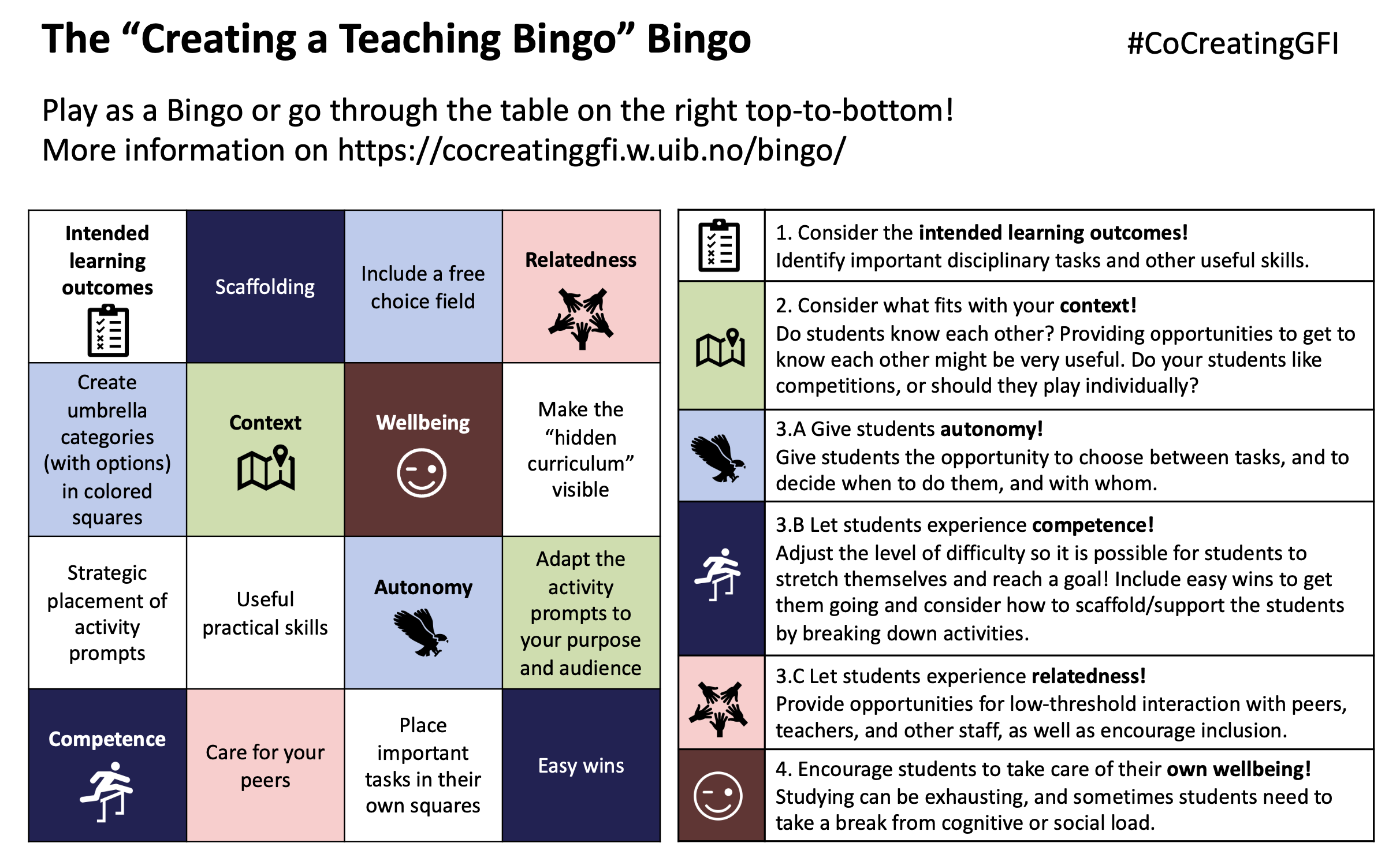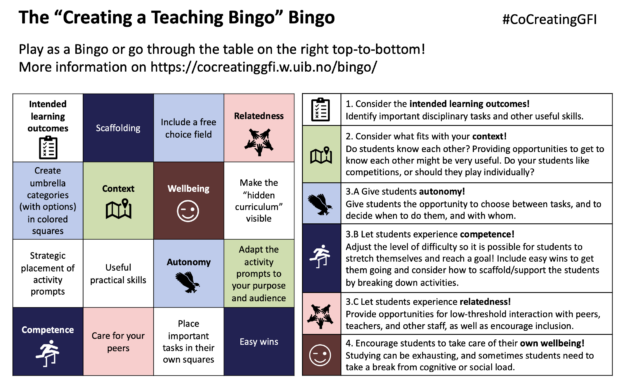We have recently shared our experiences with a Bingo game to nudge students to make the most out of fieldwork (Glessmer et al., 2023), and I have created Bingos for other purposes, like designing courses with Universal Design for Learning in mind, or for my freediving club’s summer camp, or the iEarth GeoLearning Forum 2023 (yes, you can look forward to that!). And now, Kjersti and I have come up with the Bingo of Bingos: A “how to design your Activity Bingo for teaching purposes” Bingo! Because who doesn’t love a gamified approach to basically everything?
Ok, first of: even though we present it as a Bingo and it is totally possible to play as a Bingo, your own Bingo will probably turn out best if you go through the table on the right top-to-bottom (the table in the Figure on top or below. Yes, there might possibly have been a way to make things less confusing…), and consider each step. More on those steps here:
1. Intended learning outcomes
In good constructive alignment fashion, we start out by considering the learning outcomes of the the course in which we want to use the Bingo. What are students supposed to be able to do at the end of your course? What knowledge and skills will they need to learn to be able to do that? And are there other important tasks or skills that typically don’t get enough attention? Maybe there are practical skills that we assume students should have but are surprised every year when they don’t? Maybe skills that could help students structure their work better, like using productivity tools? There are probably a lot of small things that come to mind that seem too small to explicitly address in a course otherwise, but that could be used as tasks on a Bingo (use a spellchecker properly. Set learning management system notifications in a way they don’t miss important updates. Debug computer code. Learn knots to secure gear in the field. …). If we know what specific activities students would benefit from doing, we can include them either as explicit prompts in their own boxes on the Bingo card, or as a list to choose from.
2. Think about your context
Whether or not students are likely to enjoy ticking tasks on your Bingo card depends a lot on the context you are working with. If students don’t know each other well yet, they might enjoy, and benefit from, tasks that give them low-threshold activities to get to know each other. If competitions are a big no-no in your culture, it might be good to focus on collaboration and to not introduce time (or other) pressure (on the other hand — if competitions work well, then knock yourself out!). If they are using a Bingo in each of the courses they are taking, maybe they are experiencing Bingo overload and you shouldn’t add to that. Also, will students have enough time to do the Bingo, or is it adding more time pressure to an already overfull schedule? Bingos work really well if there are otherwise boring down times where students actually appreciate something to do (like during a night watch on a research ship, waiting for the ship to reach the next station).
3. Motivation (we like Self-Determination Theory!)
Why should our students want to play our Bingo, and engage with all the tasks we are suggesting? We are using Bingos as voluntary activities, so no bonus points or anything else forcing students to do them. So we must consider what might motivate students to engage. Intrinsic motivation requires feeling autonomous, competent, and related. So the next three sections present ideas of how to achieve that in a Bingo.
3.A Give students choice
A Bingo can easily be perceived as a checklist with more colors and a fancier format, but that is not the intention at all. In our Bingos, in addition to explicit prompts for action, we introduce categories (the boxes with icons). The categories are described in the table on the right and suggest actions that students could pick from, or leave them the choice to do something else related to that category. We often (although not in this Bingo) add boxes that are “free choice”, so students can do anything that they think they would benefit from doing to make the most of the environment they are in.
3.B Let students feel competent
We have made positive experiences with including some tasks that students have to do in any case, Bingo or no Bingo, like attending the safety briefing on the research ship. That way, students can already tick a box right away without any extra effort. In general, it is good if tasks are challenging enough to be interesting, but at the same time small enough so they can be completed within a couple of minutes (like for example learning to do an eye splice). A Bingo is also an excellent way to scaffold larger tasks.
3.C Let students experience relatedness
Even though university can be an amazing experience of having fun with friends, for many students it is, at least at times, a very lonely experience. Especially for first-year students who might have moved to a new city or country, or students in courses that have been mixed together from different study programs, or fieldwork where the whole context is new and slightly scary, it is super important to make sure that students look after each other. For that, you could include explicit prompts (“introduce yourself to someone you haven’t met yet”, “ask someone a question”, “help someone with their tasks”). Also creating low-threshold opportunities to interact with teachers and other staff is a good idea (in our fieldwork bingo article, we describe how students really appreciate interacting with the crew on a research ship (and how students were surprised that the crew was also excited to interact with them) — something that they would not have done to the same extent unprompted).
4. Help students look after themselves
We initially included this category thinking about fieldwork specifically, and the need that some students might have to withdraw to their own cabin, or tent, or even just thoughts, to process and recover from the intense social situation and lots of new inputs. But this is actually relevant in all teaching situations. As much as we want students to work hard, we also want them to recover and recharge sufficiently, so they can keep up motivation and engagement, and stay happy and balanced. Helping students to look after themselves might be about encouraging them to take regular breaks, to schedule some time to be physically active outdoors, to connect with their loved ones. It might also be about helping them reconnect with their larger purpose, finding connections between their study task and their own values and goals. We have used very explicit prompts like “take a break outdoors” to nudge students in that direction and to show that we value them looking after themselves and don’t perceive it as them being lazy or unmotivated.
So this is how we use Bingos. How are you using them? Any comments or ideas you would be willing to share? We would love to hear from you! :-)

Download this figure as a .pdf here or by clicking on the image
Glessmer, M.S., L. Latuta, F. Saltalamacchia, and K. Daae. 2023. Activity bingo: Nudging students to make the most out of fieldwork. Oceanography, https://doi.org/10.5670/oceanog.2023.217.
